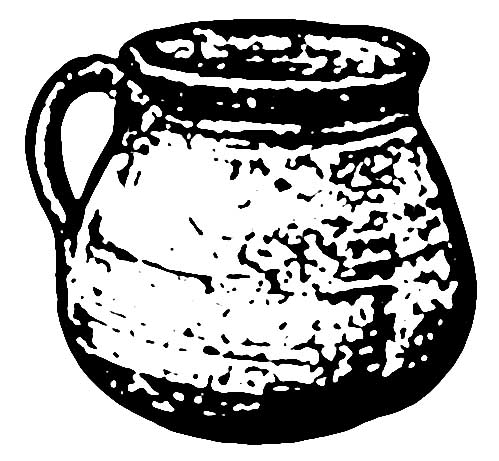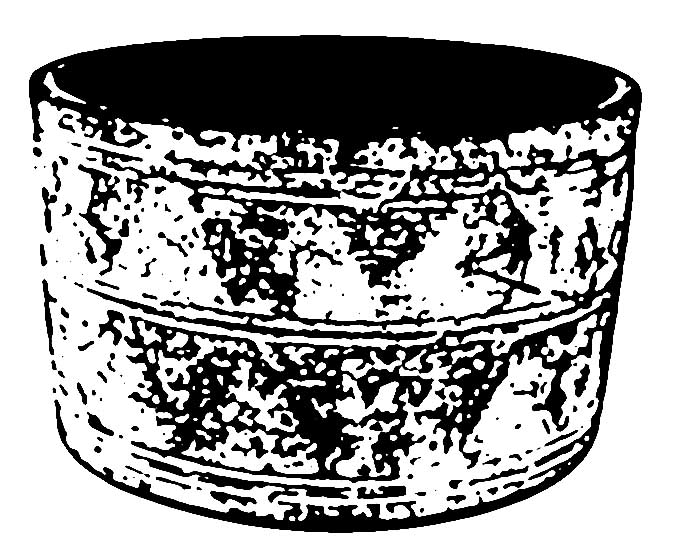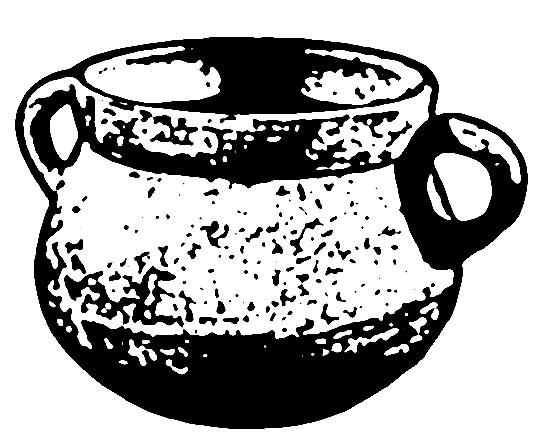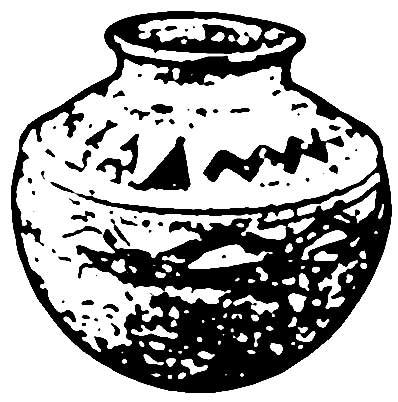Steven Skinner BlackTree Studio Ceramics

|

|

|

|

|
|
Pottery is the ceramic ware made by potters. It can also refer to the material of which the potteryware is made. Major types of pottery include earthenware, stoneware and porcelain. The places where such wares are made are called potteries. Pottery is one of the oldest human technologies and art–forms, and remains a major industry today. Ceramic art covers the art of pottery, whether in items made for use or purely for decoration. Earliest known ceramics are the Gravettian figurines that date to 29,000 to 25,000 BC It is believed that the earliest pottery wares were hand built and fired in bonfires. Firing times were short but the peak–temperatures achieved in the fire could be high, perhaps in the region of 900 degrees Celsius, and were reached very quickly. Clays tempered with sand, grit, crushed shell or crushed pottery were often used to make bonfire–fired ceramics, because they provided an open body texture that allows water and other volatile components of the clay to escape freely. The coarser particles in the clay also acted to restrain shrinkage within the bodies of the wares during cooling, which was carried out slowly to reduce the risk of thermal stress and cracking. In the main, early bonfire–fired wares were made with rounded bottoms, to avoid sharp angles that might be susceptible to cracking. The earliest intentionally constructed kilns were pit–kilns or trench–kilns; holes dug in the ground and covered with fuel. Holes in the ground provided insulation and resulted in better control over firing. The earliest known ceramic objects are Gravettian figurines such as those discovered at Dolni Vestonice in the modern–day Czech Republic. The Venus of Dolní Vestonice (Vostonická Venue in Czech) is a Venus figurine, a statuette of a nude female figure dated to 29,000–25,000 BCE (Gravettian industry). The earliest pottery vessel found to date was excavated from the Yuchanyan Cave in southern China and the Proceedings of the National Academy of Sciences in 2009 reports that the ware dates back to 18,000 years ago. Pottery vessels made by the Incipient Jomon people of Japan from around 10,500 BCE have also been found. The term "Jomon" means "cord–marked" in Japanese. This refers to the markings made on clay vessels and figures using sticks with cords wrapped around them. Pottery which dates back to 10,000 BCE have also been excavated in China. It appears that pottery was independently developed in North Africa during the tenth millennium b.p. and in South America during the seventh millennium b.p. The earliest history of pottery production can be divided into 4 periods namely; the Hassuna period (5000 – 4,500 BCE), the Halaf period (4,500 – 4000 BCE), the Ubaid period (4000 – 3000 BCE), and the Uruk period (3,500 – 2000 BCE). The invention of the potter's wheel in Mesopotamia sometime between 6,000 and 4,000 BCE (Ubaid period) revolutionized pottery production. Specialized potters were then able to meet the expanding needs of the world's first cities. Pottery was in use in ancient India during the Mehrgarh Period II (5500 – 4800 BCE) and Merhgarh Period III (4800 – 3500 BCE), known as the ceramic Neolithic and chalcolithic. Pottery, including items known as the ed–Dur vessels, originated in regions of the Indus valley and has been found in a number of sites in the Indus valley civilization. In the Mediterranean, during the Greek Dark Ages (1100–800 BCE), artists used geometric designs such as squares, circles and lines to decorate amphoras and other pottery. The period between 1500–300 BCE in ancient Korea is known as the Mumun Pottery Period. The quality of pottery has varied historically, in part dependent upon the repute in which the potter's craft was held by the community. For example, in the Chalcolithic period in Mesopotamia, Halafian pottery achieved a level of technical competence and sophistication, not seen until the later developments of Greek pottery with Corinthian and Attic ware. The distinctive Red Samian ware of the Early Roman Empire was copied by regional potters throughout the Empire. The Dark Age period saw a collapse in the quality of European pottery which did not recover in status and quality until the European Renaissance. For archaeologists, anthropologists, and historians the study of pottery can help to provide an insight into past cultures. Pottery is durable and fragments, at least, often survive long after artifacts made from less–durable materials have decayed past recognition. Combined with other evidence, the study of pottery artifacts is helpful in the development of theories on the organisation, economic condition and the cultural development of the societies that produced or acquired pottery. The study of pottery may also allow inferences to be drawn about a culture's daily life, religion, social relationships, attitudes towards neighbors, attitudes to their own world and even the way the culture understood the universe. Chronologies based on pottery are often essential for dating non–literate cultures and are often of help in the dating of historic cultures as well. Trace element analysis, mostly by neutron activation, allows the sources of clay to be accurately identified and the thermoluminescence test can be used to provide an estimate of the date of last firing. Examining fired pottery shards from prehistory, scientists learned that during high–temperature firing, iron materials in clay record the exact state of Earth's magnetic field at that exact moment. . . . Pottery is made by forming a clay body into objects of a required shape and heating them to high temperatures in a kiln to induce reactions that lead to permanent changes, including increasing their strength and hardening and setting their shape. There are wide regional variations in the properties of clays used by potters and this often helps to produce wares that are unique in character to a locality. It is common for clays and other minerals to be mixed to produce clay bodies suited to specific purposes. Prior to some shaping processes, air trapped within the clay body needs to be removed. This is called de–airing and can be accomplished by a machine called a vacuum pug or manually by wedging. Wedging can also help to ensure an even moisture content throughout the body. Once a clay body has been de–aired or wedged, it is shaped by a variety of techniques. After shaping it is dried before firing. There are a number of stages in the drying process. Leather–hard refers to the stage when the clay object is approximately 75–85% dry. Clay bodies at this stage are very firm and only slightly pliable. Trimming and handle attachment often occurs at the leather–hard state. Clay bodies are said to be "bone–dry" when they reach a moisture content at or near 0%. Unfired objects are often termed greenware. Clay bodies at this stage are very fragile and hence can be easily broken. The potter's most basic tool is the hand. However, many additional tools have been developed over the long history of pottery manufacturing, including the potter's wheel and turntable, shaping tools (paddles, anvils, ribs), rolling tools (roulettes, slab rollers, rolling pins), cutting/piercing tools (knives, fluting tools, wires) and finishing tools (burnishing stones, rasps, chamois). Pottery can be shaped by a range of methods that include: Hand building. This is the earliest forming method. Wares can be constructed by hand from coils of clay, from flat slabs of clay, from solid balls of clay – or some combination of these. Parts of hand–built vessels are often joined together with the aid of slurry or slip, an aqueous suspension of clay body and water. Hand building is slower and more gradual than wheel–throwing, but it offers the potter a high degree of control over the size and shape of wares. While it isn't difficult for an experienced potter to make identical pieces of hand–built pottery, the speed and repetitiveness of other techniques is more suitable for making precisely matched sets of wares such as table wares. Some studio potters find hand building more conducive to fully using the imagination to create one–of–a–kind works of art. The potter's wheel. In the process that is called "throwing" (coming from the Old English word thrawan, which means to twist or turn), a ball of clay is placed in the center of a turntable, called the wheel–head, which the potter rotates with a stick, or with foot power (a kick wheel or treadle wheel) or with a variable speed electric motor. (Often, a disk of plastic, wood or plaster – called a bat – is first set on the wheel–head, and the ball of clay is thrown on the bat rather than the wheel–head so that the finished piece can be removed intact with its bat, without distortion.) During the process of throwing the wheel rotates rapidly while the solid ball of soft clay is pressed, squeezed, and pulled gently upwards and outwards into a hollow shape. The first step of pressing the rough ball of clay downward and inward into perfect rotational symmetry, is called centering the clay, a most important (and often most difficult) skill to master before the next steps: opening (making a centered hollow into the solid ball of clay), flooring (making the flat or rounded bottom inside the pot), throwing or pulling (drawing up and shaping the walls to an even thickness), and trimming or turning (removing excess clay to refine the shape or to create a foot). From around 7th century BC until the introduction of slip casting in the 18th century AD, the potter's wheel was the most effective method of mass producing pottery[citation needed], although it is also often employed to make individual pieces. Wheel–work makes great demands on the skill of the potter, but an accomplished operator can make many near–identical plates, vases, or bowls in the course of a day's work. Because of its inherent limitations, wheel–work can only be used to create wares with radial symmetry on a vertical axis. These can then be altered by impressing, bulging, carving, fluting, faceting, incising, and by other methods making the wares more visually interesting. Often, thrown pieces are further modified by having handles, lids, feet, spouts, and other functional aspects added using the techniques of handworking. Granulate pressing: As the name suggests, this is the operation of shaping pottery by pressing clay in a semi–dry and granulated condition in a mould. The clay is pressed into the mould by a porous die through which water is pumped at high pressure. The granulated clay is prepared by spray–drying to produce a fine and free flowing material having a moisture content of between about five and six per cent. Granulate pressing, also known as dust pressing, is widely used in the manufacture of ceramic tiles and, increasingly, of plates. Jiggering and jolleying: These operations are carried out on the potter's wheel and allow the time taken to bring wares to a standardized form to be reduced. Jiggering is the operation of bringing a shaped tool into contact with the plastic clay of a piece under construction, the piece itself being set on a rotating plaster mould on the wheel. The jigger tool shapes one face whilst the mould shapes the other. Jiggering is used only in the production of flat wares, such as plates, but a similar operation, jolleying, is used in the production of hollow–wares, such as cups. Jiggering and jolleying have been used in the production of pottery since at least the 18th century. In large–scale factory production jiggering and jolleying are usually automated, which allows the operations to be carried out by semi–skilled labor. Excerpted from: wikipedia.org |
|
|
Pottery |
|